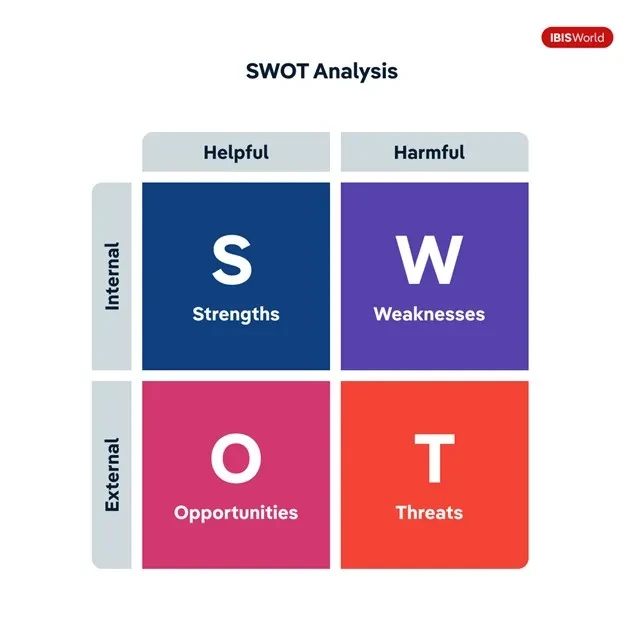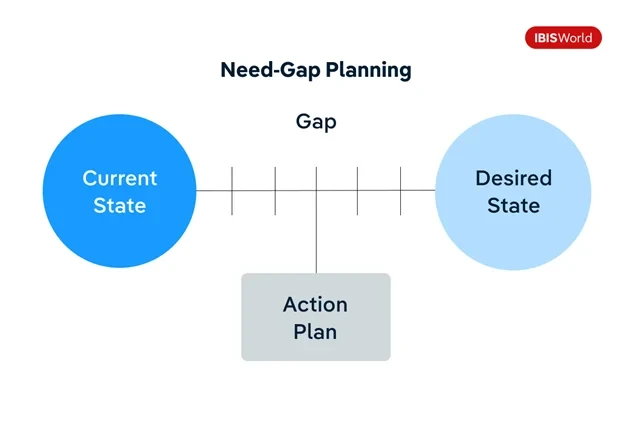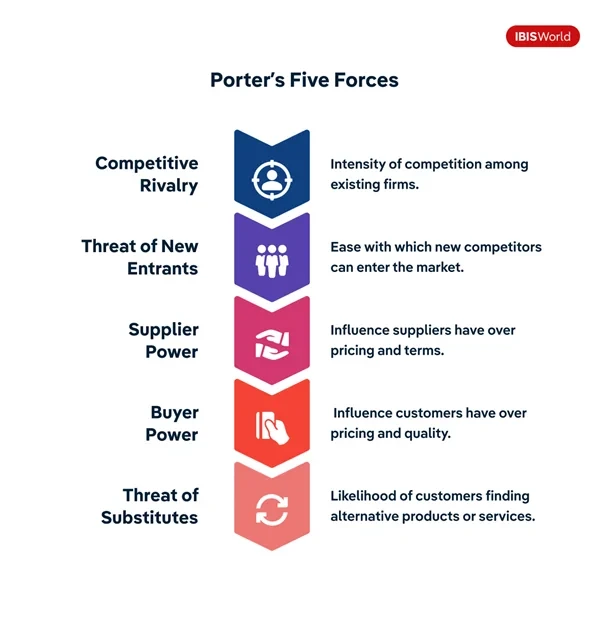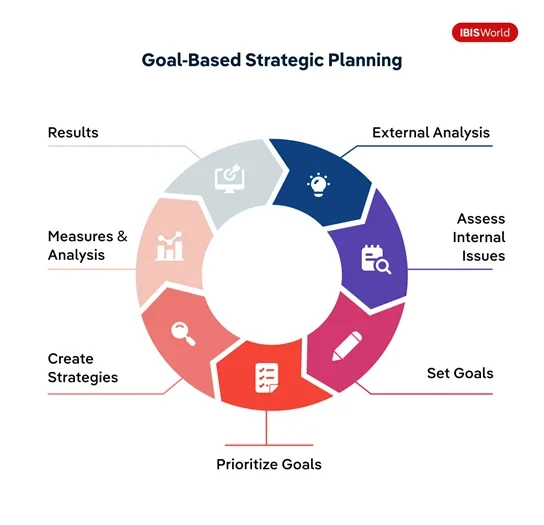Key takeaways
Strategic planning can transform businesses by proactively addressing challenges, but it can also merely justify the year’s actions.
Each strategic planning framework has strengths and weaknesses. Some are better suited for internal challenges, while others focus on shaping strategy outward.
Industry research plays a critical role in strategic planning. It helps provide actionable insights, identify emerging trends and inform decision-making processes.
We’ve all been there. It’s the end of a presentation on the “strategies” the business plans to employ to hit a goal. As a listener, you appreciate the work put into the presentation, but your mind is spinning. Where is the focus? Was that a strategy or merely a lot of positive thinking? Have we defined what the key challenge is? Was that just a list of our sales tactics?
Strategic planning allows a business to use its resources to overcome pressing challenges. Too often, however, these plans are a means to an end–a document to justify the business’s actions in the year ahead.
In one of the best books on strategy, ‘Good Strategy, Bad Strategy,’ business professor Richard Rumelt simplifies the word strategy as “a diagnosis, a guiding policy and coherent action.” In other words, a strategy (and subsequent planning) requires first identifying one’s most pressing challenge.
In 2024, business challenges are everywhere: emerging technologies, increased compliance expectations, cybersecurity threats, rising costs, skill gaps, economic uncertainty — the list is long. With these pressures, businesses must deeply understand the landscape of their customers, competitors and supply chain. Research can provide a broader view of these challenges as you hone your focus on your biggest and most imminent challenge.
What is Strategic Planning?
Put simply, strategic plans articulate how a business will grow despite challenges. The key components of a strategic plan are the company’s mission statement, industry analysis, ideal customer profile, analysis of key challenges, timebound goals, key performance indicators, key personnel and financial projections.

While many businesses used to conduct strategic planning every 3 to 5 years, the high rate of technological and global economic change has caused many executives to update plans on a rolling basis. This approach helps account for when the operating environment drastically changes, when you experience a big hit to your sales that you can’t explain, or, in the best case, when you’ve met your last plan’s goals.
Whatever the reason, understanding your business’s competitive landscape is a critical component of any new or updated plan. Learning more about your competitors’ performance, barriers for new entrants, trends in your target market and general industry performance can provide perspective that lifts the blinders from your team’s strategic thinking.
Rumelt writes, “Bad strategy is more than just the absence of good strategy. […] Bad strategy may actively avoid analyzing obstacles because a leader believes that negative thoughts get in the way. Leaders may create bad strategy by mistakenly treating strategy work as an exercise in goal-setting rather than problem-solving.”
By assessing not only the internal challenges, such as skill gaps, process deficiencies or mismatched scaling abilities across teams, but also the external environment, businesses can identify one or more core problems that should be foundational to their strategy.
Key Strategic Planning Frameworks
Before creating the plan itself, many businesses rely on strategic planning frameworks to explore their challenges and opportunities. Four common frameworks include SWOT & PESTLE Analysis, Need-Gap Planning, Porter’s 5 Forces and Goal-Based Strategic Planning. These planning types are recommended because they combine inward and outward perspectives.
SWOT & PESTLE Analysis
SWOT + PESTLE Analysis combines two frameworks: The most basic and commonly used framework is SWOT, wherein leaders review the strengths, weaknesses, opportunities and threats faced. SWOT analysis is a strategic planning tool used to identify and evaluate these four key elements of an organization or project. Strengths and weaknesses are typically internal factors, such as resources and capabilities, whereas opportunities and threats are external factors, such as market trends and competition.

Larger companies that are subject to the impact of macro events often include PESTLE (political, economic, social, technological, legal, environmental) analysis. PESTLE analysis is a framework used to analyze and monitor the external macro-environmental factors that may impact an organization. This tool helps companies understand how various external factors influence their business and make more informed strategic decisions.

According to the Harvard Business Review, focusing on strengths and weaknesses first can bias an organization toward its internal environment. Because of our nature to jump to solutions, starting with internal strengths and weaknesses leads some strategic planners to skim over their opportunities and threats. The authors argue that businesses should deeply understand their environment and mine their internal strengths to solve those problems.
By combining SWOT with PESTLE, companies can enhance their planning ahead of strategic decision-making. Industry analysis, including macroeconomic headwinds and tailwinds, is a key step toward identifying the largest challenge for your business. This framework is beneficial during significant market changes or when entering new markets, as it provides a comprehensive view of internal and external factors.
Key Considerations When Implementing SWOT & PESTLE Analysis
- Combine SWOT and PESTLE to evaluate both internal factors and external factors.
- Start with external opportunities and threats to avoid internal bias and make well-rounded, informed strategic decisions.
- Conduct industry analysis to understand macroeconomic influences and identify significant challenges.
- Continuously monitor and update your analysis to ensure it reflects current internal and external environments.
Need-Gap Planning
Need-Gap Planning is a strategic framework designed to identify and bridge the discrepancy between an organization’s current state and desired future state. This process involves a thorough assessment of existing conditions, setting clear objectives for the future, pinpointing the gaps that impede progress and developing actionable strategies to address these gaps.

Typically, the process begins with a SWOT analysis (Strengths, Weaknesses, Opportunities, Threats), which helps understand both internal and external factors affecting the organization. The key outcome of Need-Gap Planning is identifying challenges and formulating detailed plans to overcome them, ensuring that the organization moves efficiently toward its goals.
Need-Gap Planning is particularly useful in business transformation, performance improvement, market expansion and product development scenarios. During business transformations, it helps companies align resources and efforts with new strategic directions. For performance improvement, organizations can use this framework to identify performance bottlenecks and devise strategies to enhance productivity. When aiming for market expansion, companies can leverage Need-Gap Planning to understand market demands and competitive landscapes, ensuring a strategic approach to growth. In product development, the framework assists in identifying customer needs and market gaps, leading to the creation of products that address these unmet demands.
Industry research about a business’s operating environment and supply chain is critical to understanding where the largest gaps are and where the biggest return on investment in addressing them is.
Key Considerations When Implementing Need-Gap Planning Frameworks
- Begin with a comprehensive SWOT analysis to ensure a well-rounded view of your organization’s current state.
- Define specific, measurable objectives for the desired future state to provide clear direction and focus for strategic initiatives.
- Pinpoint the gaps between the current and desired states and develop actionable strategies to bridge these gaps.
- Utilize Need-Gap Planning for various scenarios such as business transformation, performance improvement, market expansion, and product development.
Porter’s 5 Forces
Like SWOT analysis, Porter’s 5 Forces is a commonly used framework that helps businesses understand the competitive landscape of their industry. This framework assesses five factors: competitive rivals, potential for new entrants, supplier power, buyer power and threat of substitutes.

Competitive rivals are the number of competitors within the industry, including the intensity of competition and the barriers to exit. High competition can reduce overall profitability as firms may engage in price wars or increased marketing efforts. These competitive tactics, combined with substantial barriers to exit, such as long-term contracts and significant infrastructure investments, can significantly reduce overall profitability. New competitors can enter the market if these companies consider barriers to entry, such as high capital requirements, economies of scale and strong brand loyalty among existing customers. Higher barriers to entry tend to lower the threat of new entrants.
Supplier power examines the number of suppliers in the industry, the uniqueness of their products or offerings and their ability to influence prices. Few suppliers or unique products can give suppliers considerable power over the industry. On the other hand, buyer power assesses how much influence customers have on pricing and quality. Increased buyer power occurs when customers have many choices and low switching costs, enabling them to demand better terms and lower prices.
The threat of substitution reckons with alternative products or services that can replace the industry’s offerings. A high threat of substitution within an industry can limit profitability as customers may switch to alternatives, especially if these options offer better costs or product performance.
In this way, industry information is critical to fully assessing Porter’s 5 Forces. Industry research providers who deeply understand how industries operate, the macroeconomic factors driving or challenging an industry and the interplay between upstream and downstream activities are best placed to provide meaningful context to a business’s Porter’s 5 Forces analysis.
Key Considerations When Implementing Porter’s 5 Forces Analysis
- Evaluate the number and intensity of competitors and barriers to exit to gauge profitability impacts.
- Analyze the ease of market entry for new competitors, considering factors like capital requirements and brand loyalty.
- Determine the influence of suppliers and buyers on pricing and terms by examining their number and options.
- Consider the threat of substitutes by identifying alternative products that could replace your offerings.
- Conduct this analysis when entering a new market, evaluating industry attractiveness, or adjusting strategies.
Issue- (or Goal-) Based Strategic Planning
Issue-Based and Goal-Based Strategic Planning frameworks are essentially the same, working from opposite directions. Issue-Based planning requires identifying the core issues and outlining the plans to resolve them. This framework is advantageous when an organization faces immediate problems or challenges that must be addressed to ensure stability and growth. It allows leaders to focus on critical issues, prioritize them and develop actionable strategies to overcome these obstacles.

On the other hand, Goal-Based Planning is a useful framework when a business or leader has envisioned an aspirational end state. Instead of working forward from issues and challenges, a Goal-Based Plan works backward from a desired outcome.
This approach is beneficial when the organization has long-term objectives and aims to achieve specific milestones. By setting clear goals, the organization can align its resources and efforts to systematically work towards these targets. This method encourages strategic thinking and proactive planning to reach the envisioned future state.
In either issue-based or goal-based planning frameworks, it is crucial to understand the landscape in which you’re operating. By reviewing your broader industry’s current performance and outlook, you can understand what your competitors are doing and the major tests analysts believe your industry will face in the coming period. Conducting a thorough industry analysis helps identify external factors that could impact your strategic plans. These factors include market trends, technological advancements, regulatory changes and economic conditions. This knowledge empowers leaders to make informed decisions and adapt strategies and stay competitive.
Key Considerations When Implementing Issue- (Or Goal-) Based Strategic Planning
- Clearly identify whether you’re addressing immediate issues or pursuing long-term goals to set the framework’s direction.
- Analyze industry trends, competitors, and market dynamics to understand external factors influencing your strategic decisions.
- Focus on initiatives that align with your organization’s capabilities and market opportunities to maximize impact and strategic alignment.
- Combine issue-based and goal-based planning to balance short-term problem-solving with long-term strategic vision for comprehensive strategy development.
Final thoughts
At IBISWorld, we often talk about the three horizons for business planning. The first horizon is operating efficiency, which focuses on what we are doing this year to satisfy our clients, maximize what we have brought to market and free up additional resources to keep building our dreams. On the second horizon, we look at sustaining future growth, asking what we are building to continue solving our clients’ business problems and meeting our growth goals. Finally, on our third horizon, market-building, we ask what new issues we can solve for our clients and how we can expand our markets. In this way, we are always planning, performing, iterating, evaluating and starting all over again.
A crucial element in navigating these horizons is looking outside our four walls to inform our strategic planning. By leveraging industry insights, companies can better understand market trends, anticipate shifts and identify emerging opportunities. Research empowers us to make informed decisions, tailor our approaches to meet evolving client needs and stay ahead of the competition. Through continuous evaluation and adaptation, grounded in comprehensive research that has been vetted by human judgment, businesses are better equipped to achieve sustained success and drive innovation.
Source from IBISWorld
Disclaimer: The information set forth above is provided by ibisworld.com independently of Alibaba.com. Alibaba.com makes no representation and warranties as to the quality and reliability of the seller and products. Alibaba.com expressly disclaims any liability for breaches pertaining to the copyright of content.




